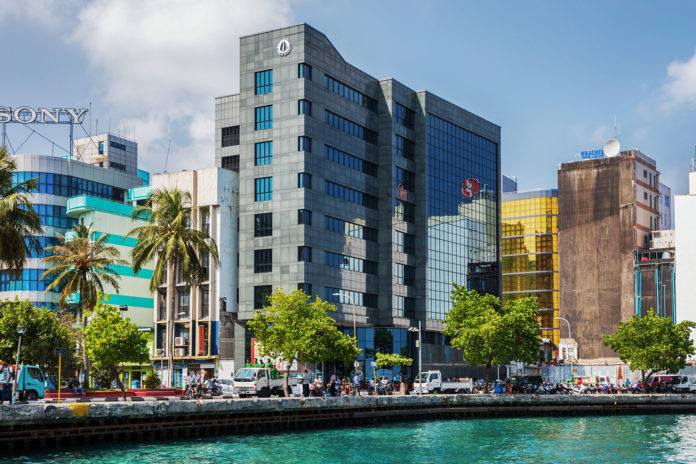
(The following statement was released by the rating agency) HONG KONG, May 15 (Fitch)
Fitch Ratings-Hong Kong-15 May 2017: Fitch Ratings has assigned The Republic of Maldives first-time Long-Term Foreign- and Local-Currency Issuer Default Ratings (IDRs) at ‘B+’. The Outlook on the ratings is Stable. The Country Ceiling is assigned at ‘BB-‘ and the Short-Term Foreign- and Local-Currency IDRs at ‘B’.
KEY RATING DRIVERS
The ratings balance the Maldives’ advanced economic development, strong GDP growth and high government revenue generated by a prosperous tourism sector against a high government debt burden and low foreign-reserve buffers. The country’s high dependence on a single sector causes volatility in economic metrics, such as GDP growth, and makes the country vulnerable to external shocks and domestic developments that undermine the Maldives’ attractiveness as a tourist destination – for example, changes in perceptions of safety.
The Maldives’ success as a prime luxury tourist destination has generated relatively high GDP per capita of USD9,145 (‘B’ category median is USD3,362). Real GDP growth has proved volatile in the last few years, illustrating the dependency of the tourism sector on global growth. Fitch expects real GDP growth to pick up to 4.0% in 2017 and 4.5% in 2018, from 3.9% in 2016, due to continued tourism demand and construction. New resorts are being built and the government has initiated large infrastructure projects. These include capacity expansion of the main airport; the construction of a bridge linking the capital to population centres; an advanced medical centre; and new housing. Some of these projects seem to have the potential to facilitate a surge in tourism in a few years, but execution of so many large projects at the same time has posed serious fiscal challenges.
The government laid out remedial measures to avoid a blow-out of government debt in its latest budget announced at end-2016. It indicated its intention to significantly increase the amount of revenue raised and to cut current expenditure to make fiscal space for the large construction projects underway. Fitch believes the official target of reducing the fiscal deficit from the government’s estimate of 7.4% of GDP in 2016 to 0.5% in 2017 seems highly ambitious, but the remedial action should significantly lower the deficit to 4.3% of GDP in 2017 and 3.5% in 2018. On the basis of the government’s announced measures and Fitch’s nominal GDP forecast, the agency expects general government debt/GDP to fall gradually from 72.3% in 2017 to 70.0% in 2020. At the same time, risks to debt sustainability remain and the stabilisation of debt, assumed by Fitch, depends on the government’s willingness and ability to follow through on its fiscal consolidation plan.
The government’s ability and propensity to tax the luxury tourism sector has led to a revenue ratio of 34.9% of GDP, significantly higher than the ‘B’ median of 24.7%. There is still potential to further increase the amount of revenue raised from tourism if needed, given the likelihood of rather inelastic demand in the luxury segment to moderate price rises. Government revenue forms an important link between tourism and other sectors of the economy.
The level of gross foreign reserves is very low, registering USD501.2 million at end-March 2017 (1.6 months of current account payments), especially considering the Maldives Monetary Authority’s peg of the Maldivian rufiyaa to the US dollar. Useable reserves, defined as gross reserves minus short-term foreign liabilities, are even lower, at USD224.7 million. The risks to external balances from the low reserve base are mitigated by the persistent current account deficits being fully financed by foreign direct investment and by the tourism sector both earning and spending in US dollars. This implies that tourism-related outflows should also fall in the case of a sudden drop in tourism-related inflows. In addition, the country has managed with similarly low levels of foreign-exchange reserves for a number of years without experiencing an exchange-rate shock. However, foreign-debt financing of the large construction projects will increase the importance of foreign-reserve buffers in the years ahead.
The high dependence on tourism implies the economy is vulnerable to sudden events that harm the perception of Maldives as a safe and reliable tourist destination. Such potential events include the emergence of political instability in an already-polarised environment or security issues.
Fitch considers that the sovereign’s exposure to banking-sector risk is relatively low. Private credit represents only 39% of GDP and the banking system is well-capitalised, with a reported Tier 1/risk-weighted asset ratio of 34% in 2016. Non-performing loans were high, at 10.7% of total loans, but are on a declining trend from a peak of 21.0% in 2012.
SOVEREIGN RATING MODEL (SRM) and QUALITATIVE OVERLAY (QO)
Fitch’s proprietary SRM assigns the Maldives a score equivalent to a rating of ‘BB-‘ on the Long-Term Foreign-Currency IDR scale. Fitch’s sovereign rating committee adjusted the output from the SRM to arrive at the final Long-Term Foreign-Currency IDR by applying its QO, relative to rated peers, as follows:
– External Finances: -1 notch to reflect exposure to low reserve coverage in combination with high dependence on one sector – tourism – and an expected accumulation of external debt in the next few years from the execution of large infrastructure projects.
Fitch’s SRM is the agency’s proprietary multiple regression rating model that employs 18 variables based on three-year centred averages, including one year of forecasts, to produce a score equivalent to a Long-Term Foreign-Currency IDR. Fitch’s QO is a forward-looking qualitative framework designed to allow for adjustment to the SRM output to assign the final rating, reflecting factors within our criteria that are not fully quantifiable and/or not fully reflected in the SRM.
RATING SENSITIVITIES
The Stable Outlook reflects Fitch’s assessment that upside and downside risks to the ratings are balanced. However, the main factors that could lead to negative rating action are:
– A significant rise in general government debt; for instance, caused by a failure of the government’s fiscal consolidation strategy.
– Balance-of-payment pressures; for instance, a fall in foreign-exchange reserves or a higher-than-Fitch-expected increase in external debt.
The main factors that could lead to positive rating action are:
– Policy initiatives that lower general government debt to levels closer to the rating category median.
– Strengthening of external buffers through accumulation of foreign-exchange reserves.
– Diversification of the economy by developing sectors other than tourism; for example, facilitated by implementing structural reforms that enhance the business environment.
KEY ASSUMPTIONS
– The world economy performs broadly in line with Fitch’s latest Global Economic Outlook.
– Tourism in the Maldives is not severely affected by a sudden outburst of political violence or security issues.













